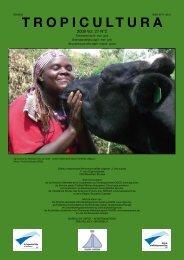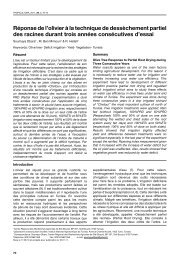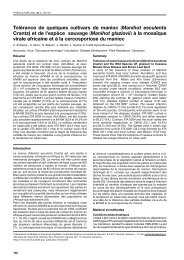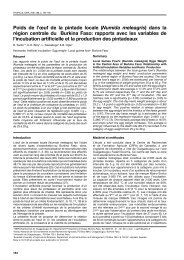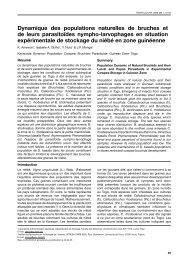Fascicule entier - Tropicultura
Fascicule entier - Tropicultura
Fascicule entier - Tropicultura
You also want an ePaper? Increase the reach of your titles
YUMPU automatically turns print PDFs into web optimized ePapers that Google loves.
TROPICULTURA<br />
Elevated Cadmium Concentrations in Potato Tubers Due to<br />
Irrigation with River Water Contaminated by Mining in Potosí,<br />
Bolivia<br />
Carla Oporto**<br />
This paper focuses on a real problem in a mining area in Bolivia where farming land has been irrigated with<br />
contaminated water since approximately 1920. It informs on the exposure of farmers working in this mining<br />
area, and in similar areas in other countries, to contamination with heavy metals contained in the ground and<br />
in the irrigation water. It provides information especially on the different concentrations of metals in farming<br />
soil and in the farming products harvested on these contaminated sites. The study analyses different factors<br />
that contribute to the bio-availability of heavy metals that can be absorbed by plants. The latter constitute a<br />
risk in the human and animal food-chain. The study reveals that the levels of heavy metals (here cadmium: Cd)<br />
contained in farming products (in this case potatoes) are very high compared with the levels observed in other<br />
countries (Australia, Sweden, Norway, Poland, Belgium, etc.). On the basis of these results, the populations<br />
living in proximity of these Bolivian mining areas, and others, can be made aware of the dangers of direct and<br />
indirect toxicity of heavy metals. This will reduce the loss of human and animal lives in the mining areas where<br />
soils are often contaminated. The results show that it is imperative that farming products harvested from the land<br />
contaminated with heavy metals are analyzed, this in accordance with European and international standards for<br />
heavy metal levels that are highly toxic to humans and animals.<br />
The technical scientific value of this paper and its impact in the sphere of environmental conservation in relation<br />
to contamination from heavy metals are clear. The fact that the concentrations of heavy metals (in this case<br />
Cadmium: Cd) observed on the experimental site exceed the standards recommended by the World Health<br />
Organization (WHO) should make the local people aware of the potential dangers (direct and indirect toxicity)<br />
of heavy metals in the food-chain. Similar studies may enable the competent authorities to draw up maps of<br />
contaminated farming land, in order to allow the local farming population to work in a sustainable way. These<br />
measures will enable the local population to avoid certain illnesses such as itai itai, which is caused by very high<br />
cadmium levels.<br />
This paper is of high scientific value. The experimental protocols, the way the experiments have been carried<br />
out, the data collection, the chemical and paedological analyses, the analyses of plants, soil and soil solutions,<br />
and irrigation water, etc. as well as the way the statistical data is treated are all in strict accordance with<br />
international scientific standards. The study is also being continued within the framework of a doctoral thesis<br />
at the Katholieke Universiteit Leuven. The results are very useful to the scientific world and in particular to<br />
environmental conservation and human and animal health. The results will be able to be used both in the mining<br />
areas in the South (South Africa, Democratic Republic of the Congo, Angola, etc.) and in the North.<br />
*Thierry Elvis Djonkack, 1976, Cameroonian, Master of Biochemistry, 2003. DEA in Biochemistry, 2006. Université de Yaoundé I, Cameroon.<br />
djonkack@yahoo.fr<br />
(report: Prof. emeritus P. Van Brandt, School of Pharmacy, Université Catholique de Louvain, Louvain-la-Neuve, Belgium).<br />
**Carla Oporto, 1970, Bolivian, Master of Environmental Sciences, Universidad Mayor de San Simón, Cochabamba, Bolivia, 2000. carlaoporto@gmail.com<br />
(report: Dr L. Longanza Baboy, Laboratory of Systematic Botany and Phytosociology, Université Libre de Bruxelles, Belgium and the Faculty of Agronomic<br />
Sciences, Université de Lubumbashi, Democratic Republic of the Congo).<br />
192



